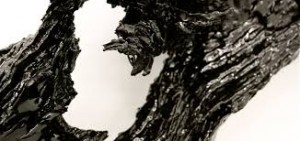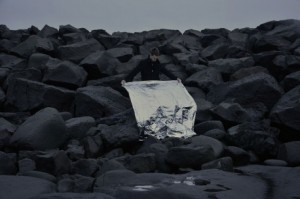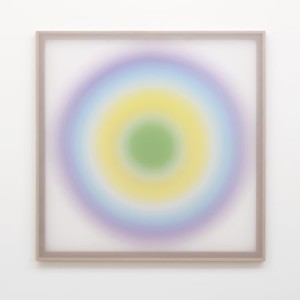Last week’s Art Fair in Melbourne brought 70 galleries from around Australia to show some 300 artists to a wider audience. It was an intense concentration of art, artists, collectors and curious onlookers with an extensive program of associated talks, dinners and gatherings, all of which injected a healthy dose of optimism, energy and dollars into the art market.
The mix of works was broad: a well-curated and organised presentation of video, public art spaces presenting projects by unrepresented artists, stalls with activities not often seen in the rarefied art environment (think tattoos, psychic readings and free-form knitting) and the usual established and emerging galleries.
There were however many galleries missing. An exhibition stand at the Fair is not guaranteed to all in the art gallery community. There are several reasons for this – one being an appropriate measure of quality control by the organisers; another, the cost which I understand is considerable and a third, just ‘not interested this year, thank you’. This desire to differentiate oneself from the Fair prompted Spring 1883, to which 20 galleries were invited by a small organising group to present a small selection of works in suites at The Hotel Windsor.
Spring 1883 deliberately targeted a more bespoke audience, as in seasoned and experienced collectors/ buyers. Each invited gallery took a suite at The Windsor and, once the small collections of small works were hung and the bed was made, opened their hotel doors to the punters.
The hurly burly of last week does need to be seen in a broader context. Whilst it is the good story, it is not the whole story. As Melbourne appears to be thriving as a cultural centre, Sydney is struggling. How many good galleries have closed in the past couple of years? How many artists will Sydneysiders no longer have regular access to? It has to be acknowledged that the commercial gallery sector has been shrinking in this town over the past couple of years, with the loss of galleries including Gallery Barry Keldoulis (Dec 2012), James Dorahy Project Space (June 2013), Breenspace (Dec 2013) and recently, Damien Minton Gallery, just to name a few.
Each respective gallerist was carefully crafting the careers of a number of respected, talented artists, and offering their works at (by international standards) very reasonable prices to a discerning audience. So what went wrong? For this handful of gallerists in particular, their passions for their artists’ potential and the place of art and culture in contemporary society was never in doubt, nor their commitment to sound business practices. But at some point, the business model was no longer viable, and the doors are closed.
Basically, commercial galleries are art shops which require sales to keep them and their artists going. Despite the crowds through the doors of the Royal Exhibitions Building in Melbourne, the market in this city (country even) to which they offer their wares is small.
The demand for contemporary art – the real thing, not the mediocre, superficial stuff – is just not there at sufficient levels to sustain the supply. Why is this? Why is becoming actively engaged with contemporary visual arts culture such a rarity? A certain level of disposable income is of course one reason but more importantly, what is at issue is the value people place on contemporary art. For most consumers, contemporary art lacks the kudos or cache that is attached to, say, a designer handbag or shoes which, though mass produced and in a similar price bracket assumes a more highly prized status. It is about what individuals perceive as prestigious and a meaningful part of their cultural engagement. Handbags and shoes add colour and pizzazz but do they add meaning to an increasingly complex contemporary world?

Neon Parc suite, Janet Beckhouse (table) and Noel Skrzypczak (walls) at The Hotel Windsor Spring 1883. Image courtesy Neon Parc.
The whirlwind event, like the Fair, certainly grabs attention and reaches out to the general public with generally more conservative, approachable art. Despite the frisson and as every gallery knows, the greatest challenge is to harness this initial enthusiasm and turn the new introductions into longer term relationships, the strength of any business.
Sally Breen offered a considered appraisal as she closed her doors. She opined that risk taking and innovation, which is at the core of contemporary art “is not always well supported [and] particularly difficult to undertake in Australia.” As to why this is difficult she says: “There are few government incentives for commercial galleries, which are among the smallest businesses in Australia, often only two or three person operations. This has a direct and deleterious effect upon artists who rely upon galleries to bring their work to the attention of collectors. The lack of depth and breadth of collecting practice and limited philanthropy compounds this difficulty, as does the expectation among a number of public and private collectors that art can be obtained at discounted prices and paid for over several months, or even years, putting tremendous commercial pressure on galleries and ultimately compromising artistic endeavour.”
What Breen is suggesting makes sense: for any industry to thrive, a defined framework is required, around which is interwoven social and political policies, together with strong legal and economic structures and a commitment to education. And this is what is lacking in and around the contemporary art industry.
So it is against this general backdrop that I applaud the ambition and optimism of the opening of any new gallery space, none of which fill the gaps of the closures of those cited above, but all of which, nonetheless, introduce a new body of artists and a fresh approach.
The Commercial is one of the relatively new galleries which had a stand out stall at the Fair. Amanda Rowell launched The Commerical in 2012 with a select stable of intriguing artists – not all young and emerging, but all with a collective sophisticated and conceptual aesthetic. She states her intentions up front, in the name chosen for her gallery though without compromising academic rigour and quality; her presentations are accompanied by intelligent writings and discussions.
Mitch Cairns who shows with The Commercial is a young artist whose work continues to evolve well. He has been seen now by thousands, with his fabulous portrait of Reg Richardson in this year’s Archibald – intricate patterns of tonal gradations which fashion a wonderful portrait.

Mitch Cairns, Portrait of Reg Richardson 2014, oil on linen, 122x102cm. Image courtesy the artist & AGNSW.
Rowell’s credentials are such that she now handles the Estates of both esteemed artists Gunther Christmann and Michael Riley.

Gunther Christmann Scholar 2011-2013 acrylic on canvas, 76x68cm. Image courtesy the Estate of the Artist and The Commercial Sydney.

Gunther Christmann Natalia M, 2011-2013, acrylic on paper on canvas. 119x90cm. Image courtesy the Estate of the Artist and The Commercial, Sydney
.M Contemporary evolved from Michelle Paterson’s long time of personal collecting. She is South African, has lived in Asia for a long time and has only (relatively) recently moved to Australia. She brings with her a refreshingly international perspective of markets not necessarily well known in Sydney as well as a passion for contemporary art. Apparently, owning a gallery has long been a dream of Paterson’s and when she found the right building last year, she bought it and the dream became a reality.
Paterson’s focus is on education and dialogue. She wants visitors to her gallery to feel comfortable, to ask questions, to look, think and talk about the artworks. She deliberately sets about creating events which make for a non-threatening, meaningful and enjoyable experience. It is about offering a different approach to potential new clients. Art on the walls with dinners in the gallery, talks with collectors, kids’ programs, even perfume information sessions around which artworks have been selected.
At this early stage (.M Contemporary opened 12 months ago), there isn’t a set stable of artists, rather a more fluid approach to sourcing a variety of emerging, established, local and internationally based artists, all of whom are seeking a public showing in Sydney. Thus far it is working well. The gallery had a stand in MAF Platform, the emerging section at the Fair, featuring an international array of work by South African artist Conrad Botes, South Korean artist Lee Sang Hyun, and Australian artist Lynne Roberts-Goodwin. And you would remember acclaimed South African artist Lyndi Sales,whom Paterson featured at Sydney Contemporary with laser-cut perspex discs?

Lynne Roberts-Goodwin Buffavento #43 from the SWARM series, C-type metallic photographic print, 100x158cm. Image courtesy the artist
At the same time, Paterson is committed to providing a forum for emerging artists. The first exhibition was the recent Engage. They are mostly younger artists, just starting out, with little track record, discovered at art school grad shows and all of whom show good potential. As a result their pricing is attractive to old and new collectors alike: nothing is over $2,000. That has to be a very realistic and competitive way in which to encourage new buyers.
In the recent Engage, Eloise Cato’s sculptural pieces were a stand out for me, strong and striking. Of varying sizes, affixed to the wall, they are discarded timber bits coated in a glossy black resin, with plastic extrusions painted in charcoal, somehow affixed and entwined. They are a deep, dense black: oil slick black, dead matt charcoal, and feel prehistoric, like fossilised forms reshaped and renewed.
An exhibition of emerging artists is incomplete without some digital media installation. Jacobus Capone’s installation Dark Learning (Act 1) comprised 2 pieces: a video and framed thermal blanket which features in the video. This is the first of what will be his life-long commitment to ongoing Acts of Dark Learning. Quiet, contemplative, subtle, they record the artist’s commitment to whichever act and the required endurance to complete the act and the moments in between …. He hails from WA, with some interesting works already under his belt, and will be a regular at .M Contemporary.
The next exhibition in this genre is Evoke, featuring artists Cathy Drew, Hana Hoogedeure, Freya Pitt and Marnie Ross. I don’t know the work by any of these artists, but am keen to be introduced. This opens 30 August.
These are sophisticated exhibitions with depth and substance, particularly given the price point and collective artists’ experiences. The aesthetic isn’t at the grunge end of the emerging spectrum which, often for dealer and audience, is difficult to tackle and commit to. What I’ve seen so far of these artists is interesting and worth pursuing – if not to collect now, then to keep tabs on for the future.
Butcher’s Hook is relatively new as well, with a similar approach to .M Contemporary, specifically targeting young, local, new collectors.
Mitchell English, an artist of some experience himself, has set up a salon-style gallery in a small terrace in William St Paddington. Renowned for its designer, bespoke stores, William Street has always been a mecca for the discerning, well-heeled buyer. It doesn’t seem to have been afflicted with the dreaded vacancy disease of its major cross street, Oxford Street, and remains a destination of style.
Butcher’s Hook (take a look, get it?) has not been refashioned with a designer interior: with a couple of pieces of domestic furniture, it feels like walking into any terrace home between Bondi and the CBD. English is aiming to step away from the gallery setting, the classic modernist white cube, and create a space which he believes is more welcoming, informal and akin to home. The works are scaled to fit, double hung, changed regularly and, like .M Contemporary, are accessible, of merit and, particularly, at a price point which makes decision-making easy. And that is English’s point – it is about showing new collectors how easy and enjoyable it is to have art in the home. He has deliberately sought out much younger artists – there is a very young teen in the group – again, whose work shows a solid understanding of practice and media, to extend themselves, by putting together a body of work for public scrutiny. And priced accordingly, the formula is working. The works are selling. Good news all round.
Currently showing is Henry Curchod whose erotic nudes evoke the dynamic lyricism of Whiteley and, having been painted directly onto MDF, they are of a confident, very masculine hand. Curchod has been selected and hung in this year’s Sulman Prize at AGNSW. Great recognition for him.

Henry Curchod Minor turbulence 2014, oil, enamel, ink & charcoal on canvas. 183x152cm. Image courtesy the artist and AGNSW
In contrast to the front room is an exhibition of small works by Kylie Elkington in the middle room. Sweet, alluring and familiar Sydney sea and landscapes, these works are well configured, well executed and lovely in feel; they have a quiet appeal.
Samantha Gazal had a show there last month: beautifully hand-crafted paper cut-outs. She cuts and glues handwritten, donated shopping lists, those endless, repetitive but so essential slips of paper, scribblings on the backs of envelopes, into exotic floral arrangements. Knowing the origins of the paper gives the works a real bite, as the repetitive drudgery of many women’s lives is made stylish and elegant. Only shopping lists and not a green bag in sight!
Another new gallery is Minerva which opened in Potts Point earlier this year in James Dorahy’s old space. It is more an artist-run space, also looking for a program which is more than the 3 week turn around exhibition of works for sale, to develop a keen group of clients.
Minerva was invited to participate in Spring 1883 last week which heralded its successful arrival on the contemporary art scene by its peers and offered a great leg-up for its artists. Minerva’s suite at The Hotel Windsor highlighted works by Jonny Niesche, very delicate screenprints on stretched silk; an installation of etched glassware and whiskey decanters (complete with whiskey) by Fayen d’Evie.
Currently showing at Minerva is a group exhibition Layer’s Thaw, around the theme of Thayer’s Law, a type of camouflage in nature identified by American painter Abbott Thayer.
The works – include film essays, a skype performance, text, installations and paintings – in Layer’s Thaw toy with versions of invisibility across identification, outline and classification. On until September 13.
Optimism and energy characterise each of these very distinctly different galleries, as well as commitment to their artists and the promotion of their works. Each has a confidence in what they are offering and an eagerness to explore different ways in which to bring new people into their exhibition spaces, to enjoy and connect with their art. They are worth adding to your list of places to patronise.
I wish them well.



























4 Comments
An information packed article, as always – thanks, Fiona!
Amazing amount information in here Fiona. Many thanks.
Good research Fiona. Yes good luck to all the new galleries. Annette
Rare to find great in depth analysis of the paradoxical and constantly shifting ground the art world is set upon. Bravo!